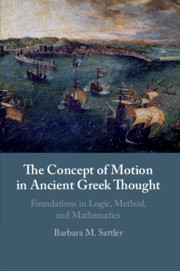Book contents
- The Concept of Motion in Ancient Greek Thought
- The Concept of Motion in Ancient Greek Thought
- Copyright page
- Contents
- Acknowledgements
- Introduction
- 1 Conceptual Foundations
- 2 Parmenides’ Account of the Object of Philosophy
- 3 Zeno’s Paradoxes of Motion and Plurality
- 4 The Atomistic Foundation for an Account of Motion
- 5 The Possibility of Natural Philosophy According to Plato I: The Logical Basis
- 6 The Possibility of Natural Philosophy According to Plato II: Mathematical Advances and Ultimate Problems
- 7 Aristotle’s Notion of Continuity: The Structure Underlying Motion
- 8 Time and Space: The Implicit Measure of Motion in Aristotle’s Physics
- 9 Time as the Simple Measure of Motion
- Bibliography
- Index Locorum
- General Index
7 - Aristotle’s Notion of Continuity: The Structure Underlying Motion
Published online by Cambridge University Press: 28 September 2020
- The Concept of Motion in Ancient Greek Thought
- The Concept of Motion in Ancient Greek Thought
- Copyright page
- Contents
- Acknowledgements
- Introduction
- 1 Conceptual Foundations
- 2 Parmenides’ Account of the Object of Philosophy
- 3 Zeno’s Paradoxes of Motion and Plurality
- 4 The Atomistic Foundation for an Account of Motion
- 5 The Possibility of Natural Philosophy According to Plato I: The Logical Basis
- 6 The Possibility of Natural Philosophy According to Plato II: Mathematical Advances and Ultimate Problems
- 7 Aristotle’s Notion of Continuity: The Structure Underlying Motion
- 8 Time and Space: The Implicit Measure of Motion in Aristotle’s Physics
- 9 Time as the Simple Measure of Motion
- Bibliography
- Index Locorum
- General Index
Summary
The basis of Aristotle’s strategy for bringing together time and distance covered in an account of motion is his understanding time, distance, and motion as continua. Against the background of Parmenides’ notion of continuity and the atomistic understanding of magnitudes, this chapter investigates Aristotle’s notion of continuity. It demonstrates the extent to which Aristotle adopts a mathematical notion of continuity according to which divisibility without end is crucial, and it expounds his appropriation of this mathematical notion for the physical realm. The main characteristics of Aristotle’s account of continuity turn out to be a new part-whole relation (in which the whole is prior to the parts since it is only by dividing the whole that we gain parts), a new account of limits, a new understanding of infinity, and a careful distinction between potential divisibility and actual division. We see how this new understanding of continuity helps counter the mereological problems of Zeno’s motion paradoxes by making it illegitimate to define time, space, and motion in terms of an additive part-whole-relation.
Information
- Type
- Chapter
- Information
- The Concept of Motion in Ancient Greek ThoughtFoundations in Logic, Method, and Mathematics, pp. 277 - 334Publisher: Cambridge University PressPrint publication year: 2020
Accessibility standard: Unknown
Why this information is here
This section outlines the accessibility features of this content - including support for screen readers, full keyboard navigation and high-contrast display options. This may not be relevant for you.Accessibility Information
- 1
- Cited by
